| Organic Seeds | Edible Plants | Organic Pest Controls | Books | Tools, Propagation & Fertilisers | Sprouting & Microgreens | Poultry Supplies | Specials & Gift Ideas |

Top

We will send an email to this address*
when is next available
* we will use this email address only for this notification and then we will delete it.
 Home
Home
Green Harvest Organic Gardening Supplies is permanently closed as of 5pm on 1-11-2023.
We will not be taking orders by this website, in person, by phone or email. Our display garden and retail shop are closed forever.
Read more...
Phone:07 54357000
Phone calls will only be responded to sporadically and only in reference to orders placed prior to 2-11-2023. All the useful growing and organic pest management research and resources are available on this website for a while still.
Easy Reference Plant Disease Control © Frances Michaels
Plant diseases can be baffling for the gardener to diagnose, even experts can have problems! A variety of microorganisms including fungi, bacteria, viruses and nematodes cause plant disease, and they are known as pathogens.
It is worth remembering that the numbers of beneficial microorganisms far outweigh the plant pathogens. Beneficial microorganisms can live in a symbiotic relationship with plants, improving their fertility and disease resistance. Other microorganisms that live in the soil are predatory, and help to suppress plant diseases; these include fungi that prey on nematodes. Most significant, though, is the cycling of organic material within the soil by the microorganisms, which cause decomposition. The organic gardener relies on this cycling to produce compost and build a healthy soil.
While it is helpful to identify plant disease, most organic solutions are aimed at being preventative, by improving the natural balance within the garden. Plant diseases have complex causes, often related to soil health and plant selection.
In addition to the organic remedies listed in the table for each disease, all of the strategies for disease control will make a difference in the long term. The simplest strategy of all, however, is to always remove a sick looking plant and destroy it; this is putting the overall health of the garden above that of an individual plant's survival.
Long Term Strategies
The overall design of your garden plays an important part in creating and maintaining 'garden health'. Make sure that the soil is well drained, that airflow is good and that only plants that like the shade are planted there. Good plant selection alone can make an enormous difference to the health of the garden.
Plant Selection
Selecting the plants most suited to your area, whether ornamentals, vegetables or fruit trees will reward you with minimal disease problems. At its most basic, being suitable means the plant evolved in a climatic zone similar to your own. So a plant native to the Mediterranean such as a fig or grape will do best in areas with dry summers. If your area has wet summers than be prepared for problems with Mediterranean plants and do your best to select a planting spot with excellent ventilation and good drainage. If you live in an area with hot, humid summers then it makes sense to select plants that have developed in these areas; most European vegetables have an Asian equivalent that is likely to be more disease resistant. So try substituting snake beans for French beans, angled luffa for zucchini, Ceylon spinach for silverbeet and so on. Getting the timing right can also reduce disease problems; avoid planting vegetables prone to rust, powdery or downy mildew just prior to periods of expected high humidity.
Be aware that buying certified disease-free planting material, particularly of strawberries and potatoes, will reduce your disease risk. Planting imported garlic, purchased at the greengrocers, also carries a serious viral disease risk.
Soil Health
Plant health is as dependent on the soil, as our own health is on what we eat. Pay attention to feeding the soil and its micro-fauna. Just as many pests are controlled in an organic garden by predatory insects so can many diseases be controlled by a diverse and abundant soil life. Increase the organic matter by composting, green manuring and mulching. Mulching acts as a barrier and helps restrict the spread of fungal spores from the soil onto the plant. Trace elements are critical to plant health; seaweed (Natrakelp) is a good way to add these essential nutrients. Avoid high nitrogen fertilisers, especially in summer when fungal problems are at their height, as soft new growth is very vulnerable to disease.
Preventative Strategies
The strategies below should be seen as a regular part of good gardening practice, they are preventative strategies rather than a response to the actual presence of disease.
Sanitation
Garden and orchard hygiene are basic to reducing disease problems, the old saying 'an ounce of prevention is worth a pound of cure' applies. Regular clean-ups are part of good gardening practice and help to prevent pathogens over-wintering in the garden. Jobs include:
Crop rotation is an essential practice for disease control. To control fungal problems, use long crop rotations of 3 to 5 years. It is important to remember to rotate the plant family, not just the individual vegetable. So if potatoes were planted in an area, a following planting would not include members of the potato family like tomatoes, capsicums and eggplants.
Watering
Keep water off the leaves as much as possible, by watering from below. Fungal spores are often spread by water droplets. Most fungal spores need to be immersed in water for a number of hours in order to germinate, black spot for example needs to be constantly moist for 7 hours to establish. If you have to overhead water, do it early in the day to allow leaves to dry off.
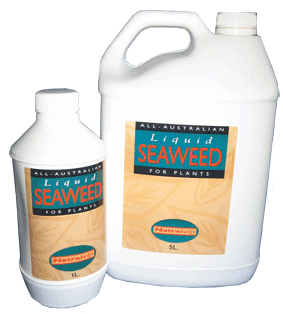 Least Toxic Sprays
Least Toxic Sprays
Organic sprays are preventative and need to be used before the disease problems are established. Summer is when fungal problems usually appear.
Seaweed Spray
Using a seaweed product such as Natrakelp as a foliar spray will provide your plants with trace elements they need to resist disease. Seaweed strengthens the plant cell walls and changes the pH of the leaf surface making it less attractive to the fungal spores. Spray every 2 to 3 weeks during peak periods for fungal disease.
Homemade Rose Fungicide
Dissolve 1 rounded tablespoon of baking soda (soda bicarbonate) in 4.5 litres of water. Add 2 ½ tablespoons of Eco-Oil. Agitate. Spray weekly as a preventative on roses for black spot and mildew.
Condy's Crystals
Condy's crystals (potassium permanganate) are used to control black spot and powdery mildew. Spray at two week intervals. To make a spray, mix 5 g of Condy's crystals with 5 litres of water, use at once.
Milk Spray
Spray with milk as a preventative fungicide for powdery mildew in a ratio of one part milk to 9 parts water. Research is being done to see why this works but the important thing is that it really does seem to work!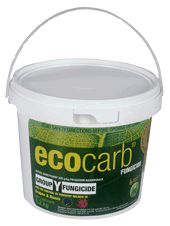
Ecocarb and Eco-fungicide are organically certified fungicides based on potassium bicarbonate. They can be used to control powdery mildew and black spot.
Lime Sulphur is used to control peach leaf curl, peach rust, shot hole, freckle and rust on stonefruit; black spot and powdery mildew on apples, roses and ornamentals. It is considered a least toxic, yet effective control for scale and mites. It is best to begin applications early in the season, since sulphur is more effective as a preventative. In subtropical areas it should be used before the high humid season.
Ideal as a winter clean up spray - spray fruit trees and roses during winter to control hard to kill pests and diseases such as mites and leaf curl. Do not use on apricots; if the temperature is over 32°C; or within 10 days of an oil spray.
Additional Strategies for Soil-borne Diseases
Solarisation
This is a useful remedy for soil-borne diseases; it can also help combat stubborn weeds. To be effective do this in summer and first water the soil well. Then cover the soil with clear 4 mm thick plastic. Stretch the plastic over the area, get it as close to the soil as possible. Bury the edges by digging a narrow trench, tucking the plastic in and back-filling. The aim is to raise the temperature to between 45°C and 50°C in the top 100 mm of soil. This is high enough to kill disease pathogens but most beneficial soil organisms will survive. Leave the plastic in place for 4 to 6 weeks and then plant as usual.
Green Manure
Plant a green manure specifically for soil diseases in beds that have had problems over the summer. Use plants such as rapeseed (canola), BQ Mulch™, marigolds or Indian mustard that contain high levels of bio-fumigant compounds. When these plants are dug into the soil, they release chemicals, which control nematodes and fungal pathogens.
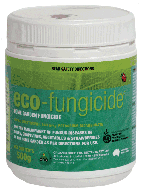 Suggested Products:
Suggested Products:
Ecocarb
Eco-fungicide
Eco-Oil
Horticultural Glues
Natrakelp
Natrasoap
Plant diseases can be baffling for the gardener to diagnose, even experts can have problems! A variety of microorganisms including fungi, bacteria, viruses and nematodes cause plant disease, and they are known as pathogens.
It is worth remembering that the numbers of beneficial microorganisms far outweigh the plant pathogens. Beneficial microorganisms can live in a symbiotic relationship with plants, improving their fertility and disease resistance. Other microorganisms that live in the soil are predatory, and help to suppress plant diseases; these include fungi that prey on nematodes. Most significant, though, is the cycling of organic material within the soil by the microorganisms, which cause decomposition. The organic gardener relies on this cycling to produce compost and build a healthy soil.
While it is helpful to identify plant disease, most organic solutions are aimed at being preventative, by improving the natural balance within the garden. Plant diseases have complex causes, often related to soil health and plant selection.
In addition to the organic remedies listed in the table for each disease, all of the strategies for disease control will make a difference in the long term. The simplest strategy of all, however, is to always remove a sick looking plant and destroy it; this is putting the overall health of the garden above that of an individual plant's survival.
| Disease Including: Fungal, Bacterial and Viral |
Plants Affected | Description and Damage | Organic Remedies General strategies that apply to all diseases are listed below the chart |
| Fungal Diseases | |||
Anthracnose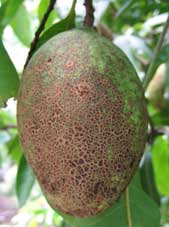 |
Rose; fruit trees including avocado, mango, macadamia; wide range of vegetables including bean, watermelon, rockmelon, tomato, cucumber and lettuce. | In roses, it can be confused with Black spot; begins as a black mark with well-defined margins but the centre turns grey and falls out, leaving a black edge. In fruits, circular, sunken spots or craters are formed. Prevalent in cool, humid weather. Spread by gardeners, tools, seed and rain. |
|
Black Spot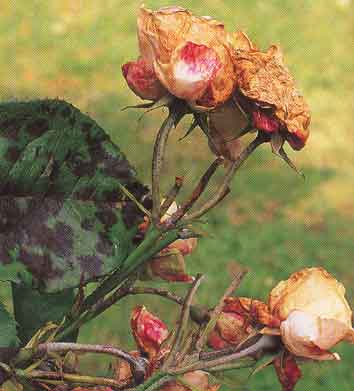 |
Rose. | Black spots with fringed margins on the upper leaf surface, stems and branches. Leaves yellow and fall. Spread by wind, water, gardeners and insects. Worse in warm, humid conditions. |
|
| Botrytis (Grey mould) |
Wide variety of plants including strawberry, grape, berry, ornamentals and rose. | Furry, grey fungus growth covers affected parts. Strawberries become soft, rotten and pale. Worse in cool, humid weather. |
|
| Brown Rot |
Stonefruit. | Kills blossoms, rots fruit on trees or after harvesting; twig infections show small cankers with gum extruding. Infected fruit has buff coloured powdery spores on soft brown rot. | Stone fruit can be pruned as soon as the fruit is harvested. Clean up dead leaves,
remove 'mummified' fruit and prune off diseased wood. Burning prunings (where possible) is the most
effective way of destroying spores. Spray with
eco-fungicide
in winter. |
| Collar Rot |
Citrus. | This is a soil fungus that attacks the tree trunk at ground level and if left untreated can kill the tree. The first signs are splitting, oozing bark and yellowing foliage. | Avoid wetting the trunk when watering. Good air circulation is needed, prevent
mulch or long grass building up around the base of the trunk. Avoid using a brushcutter close to fruit
trees, as it is a common cause of injury. If the infected area extends fully around the tree trunk,
then buy a new tree. If the tree is still viable then treat by cutting affected wood back to clean bark
using a sharp knife or chisel. Shape the wound to allow for water drainage. |
| Damping Off |
Seedlings. | Seeds rot before germination or the stem of the seedling shrivels at ground level. | Keep mulch clear of seedling stems in hot, humid weather. Use a good quality seed
raising mix. Oxygen is important to the seed's ability to successfully germinate, so avoid over-watering
and overcrowding. |
| Downy Mildew |
Wide range of vegetables, ornamental plants and fruit trees including grape. | Small, angular, light yellow or brownish spots appear on the upper surface of
leaves. Underneath the leaf these spots produce white fluffy spores. It causes stunting, wilting,
yellowing and the death of seedlings. It is common in cool, wet weather. Spread by wind. |
|
Peach Leaf Curl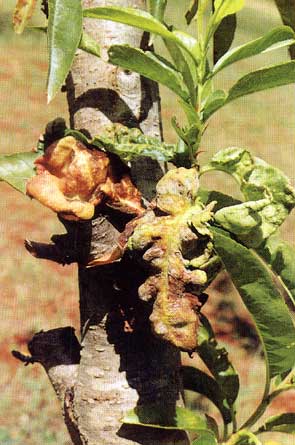 |
Stone fruit particularly peach, nectarine and almond. | Thickened pinkish or green blisters on the leaves, tree may become completely defoliated. Spread by water. | Collect mummified fruit; destroy by burning in a wood heater or burying in a deep hole. Spray at early bud swell with Lime Sulphur. |
Powdery Mildew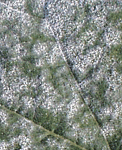 |
Wide range of vegetables including pumpkin, cucumber, pea and turnip; ornamentals including rose and crepe myrtle; fruit trees including grape, pawpaw, strawberry and apple (particularly Jonathan, Gravenstein and Rome Beauty). | Circular white powdery spots on older leaves and stems. These spread, the leaves die, cropping is reduced. Spread by wind. Worse in dry weather with evening dew. | Mulch. Avoid overhead irrigation. Select resistant varieties. Remove leaves as soon as they are affected; thousands of new spores are produced within 4 days. Spray vulnerable plants regularly with Natrakelp seaweed. After rose pruning, spray with lime sulphur. For apples, prune out infected shoots in winter. For pawpaws, dust or spray with sulphur, only when below 24°C. Spray grapes when the shoots are first starting, with Ecocarb or Eco-fungicide. Milk spray is effective. |
| Phytophthora spp. (Root Rot Fungus) |
Avocado, citrus and macadamia. | Foliage starts to die, often on just one side; the tree dies from the top down. Most common in hot, moist conditions, especially with poor drainage. Fungus lives indefinitely in the soil. | Beds should be raised to ensure good drainage. Applications of compost have been shown to reduce attack by this fungus. |
| Rust |
Wide range of vegetables including bean, beetroot, silverbeet, spinach; ornamentals including azalea, rose, geranium; stone fruit. | Orange, brown, powdery pustules underneath the leaves. Leaves yellow and drop early, plant loses vigour. Spores are spread by water and wind. | Crop rotation. Mulch. Avoid overhead irrigation. Select resistant varieties eg snake beans are resistant to bean rust. |
| Shot-hole and Freckle
|
Stonefruit, particularly Japanese plum and apricot. | Different symptoms but usually treated the same. Characteristics of shot-hole are brown leaf spots that fall out, and fruit develops scabs and gumming. Characteristics of Freckle are olive green spots on fruit and oval brown spots on twigs. | Prune trees back hard. Spray at early bud swell with Lime Sulphur. |
| Sooty Mould |
Wide range of plants including citrus and lillypilly. | Some pests, including scales and aphids, secrete large amounts of 'honeydew', which sticks to the lower leaves where it is fed on by this fungus. It looks unattractive and interferes with photosynthesis. Honeydew also attracts ants, which feed on it. The ants can 'farm' the pests, protecting them from predators. | The first step is always to control any ants, as without their protection the natural predators will usually be able to keep the pests, and therefore the sooty mould, under control. Keep ants out by banding the trunks with a horticultural glue. Prune any low branches that are touching the ground and make sure tall stems of grass aren't providing an alternative route for the ants. Sooty Mould can be controlled by spraying with Eco-Neem. |
Verticillium Wilt and Fusarium Wilt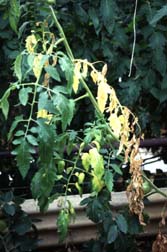 |
Wide range of plants including rose, tomato and potato. | These soil fungi invade roots and cause yellowing, stunting and rapid wilting. Spread by water, seeds and tools. More prevalent in warm, dry weather. |
|
| Bacterial Diseases | |||
| Bacterial Soft Rots |
Lettuce, carrot, celery, potato, corn, cabbage family. | Wet, slimy patches, often foul smelling. No spores present as this is not a fungus. | Avoid over-watering and watering during the heat of the day. Use strategies for soil-borne disease. Remove and destroy infected plants. Crop rotation. Select resistant varieties; open-hearted lettuces such as Cos and Mignonette lettuce are less vulnerable than crisphead types. |
| Black Rot |
Cabbage family. | Discoloured areas on stems, in cross-section black strands can be seen, causes loss of vigour, rotting and death of seedlings. Spread by infected seed, wind, water and insects. | Use strategies for soil-borne disease. Remove and destroy infected plants. Crop rotation. Select resistant varieties. If Black rot has been a problem previously, soak cabbage seed in hot water at 50°C for 23 minutes, other brassica for 18 minutes, before sowing. |
| Bacterial Canker (Gummosis) |
Stonefruit, cherry. | Cankers on twigs, dark, splitting bark. | Prune immediately, disinfecting tools and hands between cuts. |
| Viral Diseases | |||
| Mosaic |
Vegetables including cucurbits, potato, turnip; ornamentals including rose and iris. | Plants are severely stunted. Leaves are yellow and mottled, sometimes with curled leaf edges. | Spread by aphids and gardeners. Remove and destroy infected plants. Select resistant varieties. |
| Woody Passionfruit Virus |
Passionfruit. | Fruit has a thickened rind, leaves may be mottled yellow. | No cure, remove and destroy infected plants. Compost and mulch can help prevent infection. |
| Nematodes | |||
| Root Knot Nematode (Eelworms)
More Information on Nematode Control |
Wide range of plants, including rose, potato, carrot, tomato, lettuce, zucchini. | Nematodes burrow into the roots and stimulate the development of galls, or lumps on the roots. Infected plants are stunted and wilt rapidly in hot weather. On potatoes they cause wart-like lesions on the skin. | When harvesting, remove as much infected root from the soil as possible and destroy. Use strategies for soil-borne disease such as BQ Mulch™ green manure. Digging fresh chicken manure into a hot, dry soil, something normally to be avoided, has been shown to reduce nematode numbers. Leave the soil undisturbed for at least 3 weeks. Drenching with water and molasses or sugar can also kill nematodes, but will have a negative impact on soil life. |
Long Term Strategies
The overall design of your garden plays an important part in creating and maintaining 'garden health'. Make sure that the soil is well drained, that airflow is good and that only plants that like the shade are planted there. Good plant selection alone can make an enormous difference to the health of the garden.
Plant Selection
Selecting the plants most suited to your area, whether ornamentals, vegetables or fruit trees will reward you with minimal disease problems. At its most basic, being suitable means the plant evolved in a climatic zone similar to your own. So a plant native to the Mediterranean such as a fig or grape will do best in areas with dry summers. If your area has wet summers than be prepared for problems with Mediterranean plants and do your best to select a planting spot with excellent ventilation and good drainage. If you live in an area with hot, humid summers then it makes sense to select plants that have developed in these areas; most European vegetables have an Asian equivalent that is likely to be more disease resistant. So try substituting snake beans for French beans, angled luffa for zucchini, Ceylon spinach for silverbeet and so on. Getting the timing right can also reduce disease problems; avoid planting vegetables prone to rust, powdery or downy mildew just prior to periods of expected high humidity.
Be aware that buying certified disease-free planting material, particularly of strawberries and potatoes, will reduce your disease risk. Planting imported garlic, purchased at the greengrocers, also carries a serious viral disease risk.
Soil Health
Plant health is as dependent on the soil, as our own health is on what we eat. Pay attention to feeding the soil and its micro-fauna. Just as many pests are controlled in an organic garden by predatory insects so can many diseases be controlled by a diverse and abundant soil life. Increase the organic matter by composting, green manuring and mulching. Mulching acts as a barrier and helps restrict the spread of fungal spores from the soil onto the plant. Trace elements are critical to plant health; seaweed (Natrakelp) is a good way to add these essential nutrients. Avoid high nitrogen fertilisers, especially in summer when fungal problems are at their height, as soft new growth is very vulnerable to disease.
Golden Rule: stay out of the garden when it is wet.
Preventative Strategies
The strategies below should be seen as a regular part of good gardening practice, they are preventative strategies rather than a response to the actual presence of disease.
Sanitation
Garden and orchard hygiene are basic to reducing disease problems, the old saying 'an ounce of prevention is worth a pound of cure' applies. Regular clean-ups are part of good gardening practice and help to prevent pathogens over-wintering in the garden. Jobs include:
- Collection of fallen fruit and 'mummified' fruit still hanging on the tree. Feed it to animals or burn it, as compost is unlikely to be hot enough to break the disease cycle. If chickens or other animals can be allowed to forage under the trees, this job is made easier and the results are more effective.
- Disposal of infected plants is important. The usual recommendation is to burn it; this is the most effective way of destroying spores but is obviously not a very environmental solution. Sealing it in a black plastic bag, and placing it in the sun can provide enough heat to kill spores.
- Pruning of dead wood, including infected twigs that are harbouring disease.
- Disinfection of tools during and after cutting diseased wood. Do this by dipping tools into metho or a weak solution of Dettol or tea tree oil.
- Keeping on top of weeds, as they can be hosts to both pest insects and diseases. For example, chickweed is believed to be a host to tomato spotted wilt virus.
Crop rotation is an essential practice for disease control. To control fungal problems, use long crop rotations of 3 to 5 years. It is important to remember to rotate the plant family, not just the individual vegetable. So if potatoes were planted in an area, a following planting would not include members of the potato family like tomatoes, capsicums and eggplants.
Watering
Keep water off the leaves as much as possible, by watering from below. Fungal spores are often spread by water droplets. Most fungal spores need to be immersed in water for a number of hours in order to germinate, black spot for example needs to be constantly moist for 7 hours to establish. If you have to overhead water, do it early in the day to allow leaves to dry off.
 Least Toxic Sprays
Least Toxic SpraysOrganic sprays are preventative and need to be used before the disease problems are established. Summer is when fungal problems usually appear.
Seaweed Spray
Using a seaweed product such as Natrakelp as a foliar spray will provide your plants with trace elements they need to resist disease. Seaweed strengthens the plant cell walls and changes the pH of the leaf surface making it less attractive to the fungal spores. Spray every 2 to 3 weeks during peak periods for fungal disease.
Homemade Rose Fungicide
Dissolve 1 rounded tablespoon of baking soda (soda bicarbonate) in 4.5 litres of water. Add 2 ½ tablespoons of Eco-Oil. Agitate. Spray weekly as a preventative on roses for black spot and mildew.
Condy's Crystals
Condy's crystals (potassium permanganate) are used to control black spot and powdery mildew. Spray at two week intervals. To make a spray, mix 5 g of Condy's crystals with 5 litres of water, use at once.
Milk Spray
Spray with milk as a preventative fungicide for powdery mildew in a ratio of one part milk to 9 parts water. Research is being done to see why this works but the important thing is that it really does seem to work!

Ecocarb and Eco-fungicide are organically certified fungicides based on potassium bicarbonate. They can be used to control powdery mildew and black spot.
Lime Sulphur is used to control peach leaf curl, peach rust, shot hole, freckle and rust on stonefruit; black spot and powdery mildew on apples, roses and ornamentals. It is considered a least toxic, yet effective control for scale and mites. It is best to begin applications early in the season, since sulphur is more effective as a preventative. In subtropical areas it should be used before the high humid season.
Ideal as a winter clean up spray - spray fruit trees and roses during winter to control hard to kill pests and diseases such as mites and leaf curl. Do not use on apricots; if the temperature is over 32°C; or within 10 days of an oil spray.
Additional Strategies for Soil-borne Diseases
Solarisation
This is a useful remedy for soil-borne diseases; it can also help combat stubborn weeds. To be effective do this in summer and first water the soil well. Then cover the soil with clear 4 mm thick plastic. Stretch the plastic over the area, get it as close to the soil as possible. Bury the edges by digging a narrow trench, tucking the plastic in and back-filling. The aim is to raise the temperature to between 45°C and 50°C in the top 100 mm of soil. This is high enough to kill disease pathogens but most beneficial soil organisms will survive. Leave the plastic in place for 4 to 6 weeks and then plant as usual.
Green Manure
Plant a green manure specifically for soil diseases in beds that have had problems over the summer. Use plants such as rapeseed (canola), BQ Mulch™, marigolds or Indian mustard that contain high levels of bio-fumigant compounds. When these plants are dug into the soil, they release chemicals, which control nematodes and fungal pathogens.
Other Useful Organic Strategies to help with the control of pests and disease
Help with pest identification
How do you choose the right product?
How to create a pest-free, beautiful organic garden?
Organic Citrus Care
Organic Rose Care
Safe way to spray
Help with pest identification
How do you choose the right product?
How to create a pest-free, beautiful organic garden?
Organic Citrus Care
Organic Rose Care
Safe way to spray
 Suggested Products:
Suggested Products:Ecocarb
Eco-fungicide
Eco-Oil
Horticultural Glues
Natrakelp
Natrasoap
 Home
Home
Green Harvest Organic Gardening Supplies is permanently closed as of 5pm on 1-11-2023.
We will not be taking orders by this website, in person, by phone or email. Our display garden and retail shop are closed forever.
Read more...
Phone:07 54357000
Phone calls will only be responded to sporadically and only in reference to orders placed prior to 2-11-2023. All the useful growing and organic pest management research and resources are available on this website for a while still.
No liability will be accepted by Green Harvest, its owners or employees as to the accuracy of any information. No responsibility will be taken for damage to property or persons due to information given about a product or technique. No responsibility will be taken for the loss of a crop or income due to information given about a product or technique.
 Shopping here is private and secure.
Shopping here is private and secure.
Copyright © 2001 - 2024 Green Harvest Organic Gardening Supplies
No part of this website may be reproduced without permission of the owner